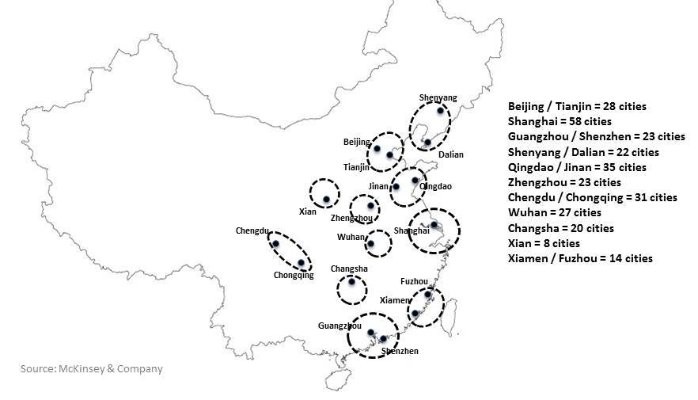
My Favorite Map for Understanding Modern China
The "cluster" map shown above (and below) is originally by McKinsey & Co. I think it really illustrates three important points about modern China.
Point 1: China today is a series of clusters, not a continent.
China today is not yet an integrated continental economy. You don’t see infrastructure seamlessly connecting each part of the country, like say in the United States. That is likely the future but not yet the present.
What you see today is a series of “clusters” - with each cluster containing 20-30 cities and typically over 60 million people. For example, Beijing / Tianjin in the North is actually a cluster of 28 cities – all increasingly interconnected by roads, rail and other new infrastructure. Qingdao, well known for its beer, is actually part of a 35-city cluster.
Point 2: These +60M person clusters are the vast majority of the economy.
China today has more than 20 of these clusters. And each is about the size of a large European country (closer to France and Germany than Greece or Austria). According to government plans, China’s main clusters will cover 80% of the GDP and 60% of the population.
Point 3: Urbanization and infrastructure are mostly about building clusters.
Much of the highly publicized high-speed rail and other infrastructure projects are about creating clusters. It is about making it possible for people and goods to travel cheaply and quickly within a cluster. Some of the projects connect the clusters. The key metric to watch is the logistics cost within clusters, which has been falling fast.
Thanks for reading.
---------------
Thanks for reading. My writing (and speaking) are on how rising Chinese consumers (and companies) are changing the world. (#ConsumerChina). This also includes work on:
- “China 2025″ – what a region transformed by Chinese consumers, companies and capital is going to look like. (#China2025)
If you would like to read my posts, please click 'Follow'.
If you would like my recommended China reading list, you can get it at www.jeffreytowson.com. You can also get a free chapter of my One Hour China Book there as well.
Some previous posts include:
- What To Do When You Fail in China (Pt 1): Danone vs. Carlsberg
- The Big Problem with China's 190M Seniors, in 1 Chart
- Three Ways Young Chinese Consumers Are Different
- Senior Housing and 3 Other China Businesses to Avoid
About: I am a Professor of Investment at Peking University Guanghua School of Management in Beijing. I am also an investor, consultant and former executive / slave to Prince Alwaleed.


Interesting, makes sense to look at it this way.
Vitesco Technologies - Head Of PM High Voltage eDrives China
5yVery interesting
Circular Thinker & Practitioner | IT Product Builder | Data-Driven Strategist | AI Enthusiast | PhD
7yAs a grown up from China, personally I am not so in favor of the clusters. Too much artificials introduced to our development but lost much its nature and original characteristics. In turn, it leads to high environmental pressure towards sustainability.